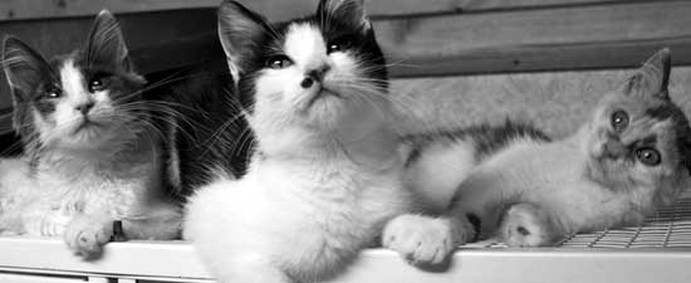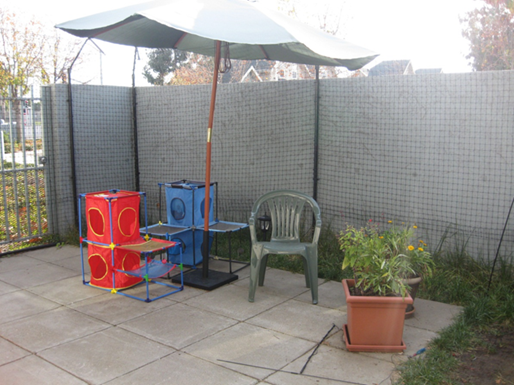Written by Meghan Shuh, UW student and 2017 Intern for Dane County Humane Society
 A kitten enjoys using a stretch and scratch post to display natural scratching behavior. Image credit: http://stretchandscratch.com/
A kitten enjoys using a stretch and scratch post to display natural scratching behavior. Image credit: http://stretchandscratch.com/ Reduced Costs
Proper feline housing and enrichment is a large component of promoting overall feline health in a shelter environment. Cats are affected in many ways by the type of housing they are kept in. Housing affects stress level, food intake, disease risk, and overall welfare. Housing has been linked to increased risk of upper respiratory infection as well as euthanasia in cats(2). Because of this, the cost of investing in proper housing and enrichment activities for cats is often returned by reduced cost in disease management and increased efficiency in caring for cats within the shelter.
In general, careful consideration should be taken when planning the location for cat housing. It is important that cats are housed away from the area that dogs are housed so that they cannot see or hear dogs in the shelter. In addition, care should be taken to reduce stress due to noise, such as the noise associated with cleaning and meal preparation.
The Cage
Cats in a shelter can be housed individually or in groups. For cats housed individually, basic space requirements must be met in order to provide humane housing for these cats. Each cat should have at least 11 square feet of space in its cage. One way to meet this space requirement is to offer cats double compartment housing. Double compartment housing can easily be achieved with standard metal cages by adding portals between adjacent cages. Portals can be made on your own using PVC pipes, or manufactured portals can be purchased via the UC Davis Shelter Medicine website.
The cage on one side of the portal can be used to house a bed, hiding box, and food and water. The other cage can be used as a bathroom area. A litter box should be supplied on this side that is an adequate size for the cat using it (ideally, at least 1.5 times the length of the cat) with at least 18 inches of clear space above the litter box so that the cat can posture normally when urinating and defecating.
Double Compartment Housing
In addition to providing adequate space for each cat, double compartment housing also promotes overall welfare by reducing stress and allowing cats to practice more natural behaviors, such as the need to separate their bathroom area from the area where they sleep and eat. It allows for more efficient cleaning, as the portals can be closed to keep the cat on one side while the other side of the cage is cleaned. This minimizes stress due to handling for the cat and decreases disease transmission by eliminating the need for care staff to handle multiple cats when cleaning cages.
The importance of providing a hiding place has already been discussed in the article, “Giving Cats a Place to Hide… IS IMPORTANT” and should be referenced for ideas on how to provide hiding places for cats.
Group Housing
Group housing is another option for cats in shelters. It is important that cats placed in group housing are carefully monitored to ensure that they are cat-social and not stressed out by being around other cats. Cats showing any signs of social stress should be removed and placed in individual housing. Signs of social stress include hiding, reduced activity, sitting with their back to the group, inappropriate elimination, and resource guarding. A program for daily monitoring should be in place to identify these cats.
Cats in group housing have a greater space requirement per cat than those housed individually. Each cat requires at least 18 square feet of space. It is often less stressful to house cats in small groups of 2-4, rather than to keep large groups of cats in larger rooms. By having smaller groups of cats, it is easier to avoid frequent additions of new cats to an already established group. One study showed that the stress associated with frequent additions of new cats to a group housing situation led to higher incidence of herpes upper respiratory infections(3).
In addition, it would be ideal to have enough litter boxes in a group housing situation so that each cat can have its own litter box. If this is not feasible, there should at least be two non-adjacent litter boxes in the room so that cats cannot easily guard each other from using the litter box. There should also be several non-adjacent feeding and watering stations for each cat in the room, and the cats should be monitoring when eating to ensure there is no guarding behavior occurring. Having sufficient hiding places and elevated surfaces is just as important for cats housed as a group as cats housed individually, as previously mentioned.
Enrichment
Providing adequate enrichment for cats in a shelter environment is important whether cats are housed individually or as a group. A lack of mental stimulation can lead to cats that are withdrawn and depressed; and therefore appear less desirable to potential adopters. These cats can be hard to identify if they are still eating, medically healthy, using the litter box appropriately, and grooming. The remainder of this article focuses on enrichment ideas for cats in shelters to help provide mental stimulation in order to keep cats behaviorally and mentally healthy as well.
Scratching Posts
Scratching posts are very important for cats. Scratching is a natural behavior for cats, and an adequate surface should be provided for cats to display this behavior. Stretch and scratch posts are available through http://stretchandscratch.com/. Shelters can add this item to their wish list, which allows donators to purchase this item and have it sent directly to the shelter. These posts are inexpensive and can be clipped onto the door of the cat’s cage so they are not taking up much space.
Toys
Toys should be provided for all cats, and these toys should be regularly rotated and changed so that cats constantly have something new to investigate and play with. Toys do not have to be expensive. Items such as crumpled paper balls, wine corks, milk caps, paper bags, etc. can be collected to be used for toys for cats. In addition, old paper towel rolls, plastic containers, egg cartons, and boxes can be used to make puzzle toys by stuffing food inside and cutting a small hole to access the food from. It may be helpful to establish a regular toy rotation schedule for cats so that each day they are offered something new.
Out of Cage Time
Out of cage time is another important part of cat enrichment. Having a room available for volunteers to play with and socialize cats outside of their cage can provide much needed mental stimulation for cats. This room and the items placed in it should be designed to be easily disinfected. Cats should be screened by a veterinarian first to ensure they are not suspected to be infected with any contagious diseases prior to being allowed to participate in out of cage time in this room. In addition, kittens under 5 months should not be permitted to participate in out of cage time so they are not exposed to potential infectious disease. If a secure outdoor area for cats can be established as weather permits, many cats enjoy being able to spend some time in an outside room sunbathing as part of their out of cage time.
Clicker Training
Clicker training is another method of providing much needed mental stimulation for cats in a shelter environment. Detailed instructions for how to clicker train cats can be found at Karen Pryor’s website, http://www.clickertraining.com/node/409. Clicker training cats to participate in activities that make them more interactive when adopters are viewing them, such as high fives or hand shakes, may help to increase desirability of these cats as potential adoption candidates. In addition, clicker training can be used to help socialize fearful and withdrawn cats, as outlined by the previously mentioned clicker training website.
Sources:
- ASPCA Professional. Enrichment for Shelter Cats. <http://aspcapro.org/resource/saving-lives-adoption-programs-behavior-enrichment/enrichment-shelter-cats>
- Gourkow, N., Factors affecting the welfare and adoption rate of cats in an animal shelter. 2001, University of British Columbia.
- Hickman, M.A., et al., An epizootic of feline herpesvirus, type 1 in a large specific pathogen-free cat colony and attempts to eradicate the infection by identification and culling of carriers. Lab Anim, 1994. 28(4): p. 320-9.
- Koret Shelter Medicine Program. UC Davis Veterinary Medicine. Enrichment recommendations for both dogs and cats in shelters. 2015. <http://www.sheltermedicine.com/library/enrichment-recommendations-for-both-dogs-and-cats-in-shelters>.
- Koret Shelter Medicine Program. UC Davis Veterinary Medicine.Feline housing considerations in a shelter/rescue, veterinary hospital, or boarding facility. 2015. <http://www.sheltermedicine.com/library/feline-housing-considerations-in-a-shelter-rescue-veterinary-hospital-or-boarding-facility >.
- Karen Pryor. Clicker Training. Clicking with Cats in the Shelter Environment. 2002. <http://www.clickertraining.com/node/409>


